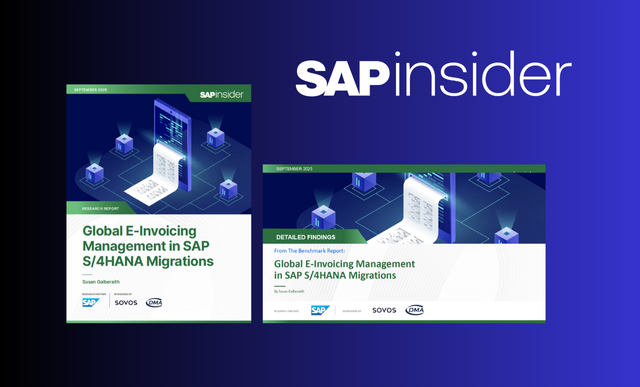How SAP Customers Can Meet the Challenges of Italy’s E-Invoicing Mandate
When Italy flipped the European Union’s (EU’s) regulations on business-to-business (B2B) electronic invoicing (e-invoicing), it opened the floodgates for the type of complex regulations companies doing business in Latin America have had to deal with for more than a decade. For SAP customers that aren’t prepared for European B2B e-invoicing, that could be very bad news.
For the uninitiated, e-invoicing is a common method of enforcing value-added tax (VAT) regulations. Companies issue electronic invoices that the government can track and effectively audit at any time. The idea is to reduce the potential for fraud by eliminating “lost” or “modified” paper receipts and other tricks some organizations use to try to save money on VAT payments.
Italy Opens Europe to E-Invoicing … and Potential Chaos
What began as a business-to-government (B2G) play first evolved in Latin American into a B2B exercise. Originally, Latin American businesses billed the government, but not each other, with electronic invoices. Then, seeing an opportunity to expand a successful anti-fraud strategy to a much greater chunk of the economy, Latin American countries, led by Brazil and Mexico, spread e-invoicing into the B2B domain.
Explore related questions
European tax authorities couldn’t do the same, however, because the EU wouldn’t allow it. EU laws prevented governments from imposing technical standards on businesses and also barred a trading partner from imposing a standard on another partner in the absence of a formal trading agreement. Seeking to fill its tax gap the way Latin American countries have for half a decade now, Italy petitioned the EU to suspend both rules temporarily — and won.
That event opened the door for potential chaos. Italy’s e-invoicing mandate takes effect Jan. 1, 2019. From that date, companies doing business there will have to issue all domestic invoices in electronic form and have them clear through the state-operated SDI e-invoicing platform. (SDI is Italy’s interchange system called Sistema di Interscambio.) The government will consider any invoices that aren’t created in the regulated FatturaPA XML format and transmitted through the SDI platform as not issued, meaning any deduction of input VAT will be disallowed and penalties will apply.
E-Invoicing Begins to Spread in Europe with Latin America as a Model
Italy continues to tinker with the e-invoicing mandate even on the eve of it taking effect. As companies with Latin American operations know, country mandates are fluid and subject to frequent changes. What’s concerning is that Europe is now poised to adopt the same country-by-country approach to e-invoicing that has come to dominate Latin America.
Greece is now working on a B2B e-invoicing system that the country’s tax authority says will be mandatory by January 2020. Portugal is mandating B2G e-invoicing beginning on Jan. 1, 2019, and could follow with a B2B model. Immediately after Italy successfully petitioned the EU, Spain allowed companies to use its B2G e-invoicing system voluntarily for B2B transactions, signaling a potential move to B2B e-invoicing. And one of the biggest economies in the region, France, is also formulating an e-invoicing plan. Countries such as Hungary and Romania have implemented VAT reporting procedures that could serve as a gateway to e-invoicing.
E-invoicing is coming to Europe, and it’s likely to follow the successful and established Latin American model. Mexico, for instance, is effectively coaching Italy on how to implement e-invoicing. The Mexican system is similar to the one the Italian government is implementing, and it is complex. It also involves real-time e-invoicing, a significant wrinkle that will likely make its way into European models and is already in place in Italy.
Here’s how real-time e-invoicing works in Mexico: Companies doing business in Mexico must generate an e-invoice in the standard format with information such as a tax ID number, description of goods, total amount of the invoice, taxes due, and much more. The shipper has to submit that invoice and then receive a unique number back from the government called a universally unique identifier (UUID). Once the government generates the UUID, the company can send the invoice to the client and ship its goods. This happens in real time. If there is a mismatch of information, the seller cannot ship its goods. The potential financial ramifications of noncompliance are massive and go far beyond penalties.
Why European E-Invoicing Is a Challenge for SAP Customers
For SAP shops, the potential for e-invoicing in Europe following the Latin American model should be a wake-up call. Just as Latin American governments develop and shift e-invoicing mandates country by country, European e-invoicing will not take place at the EU level, but on a nation-by-nation basis. As such, keeping pace with new and changing mandates in a timely manner will be very difficult.
Developing mandates in Europe will significantly affect accounts receivable (AR), accounts payable (AP), procure-to-pay, financial, general ledger, and reporting modules. The proliferation of mandates could necessitate custom coding and other resource-intensive activities to keep systems up to date. Change is what keeping up with e-invoicing is all about. New and changing mandates present difficulties because they happen country by country rather than unilaterally.
As such, IT departments are likely to spend an inordinate amount of time and resources simply trying to play catch-up in maintaining e-invoicing systems. A company working in 20 different countries might have to maintain 20 different AP, AR, and reporting solutions. It’s a major cost driver and a drain on innovation. An IT department that is bogged down in maintenance can’t innovate. It can’t drive revenue; it can only exist as a cost center.
How SAP Shops Can Master Global E-Invoicing
Far from being a drag on innovation, the e-invoicing trend in Europe and around the world can actually help SAP customers accelerate innovation. The coming influx of European mandates provides the perfect opportunity to dump the chaos of e-invoicing off on a third-party solution provider. A third party can consolidate operations in multiple countries into a single access point residing in the cloud, eliminating the need for constant maintenance and resource-sapping custom coding. E-invoicing in 20 countries moves from 20 customized systems to just one application that requires no customization.
By removing complexity, eliminating the need for customization, and establishing a single source for e-invoicing, SAP customers can free their IT staffs to innovate. When IT innovates, it can drive a company forward, becoming a revenue-producing operation rather than just a cost center. Innovation is at the heart of digital transformation; it is, in fact, what has allowed governments in Latin America and now Europe to implement e-invoicing as a VAT enforcement measure. With a third-party e-invoicing solution, SAP shops can innovate at the pace of digital business rather than being bogged down in maintaining multiple customized systems.
E-invoicing is not just a European and Latin American phenomenon. It is global in scope. Europe, however, is the next vector for rapid e-invoicing growth thanks to Italy’s successful flip of EU VAT regulations. SAP customers can get ahead of the e-invoicing trend by partnering with third-party providers for e-invoicing transactions and reporting. Those that do will be well ahead of major developments to come.
As Chief Strategy Officer at Sovos, Steve Sprague manages global messaging, product strategy, and field enablement. His experience in the electronic invoicing and middleware integration space spans two decades.








